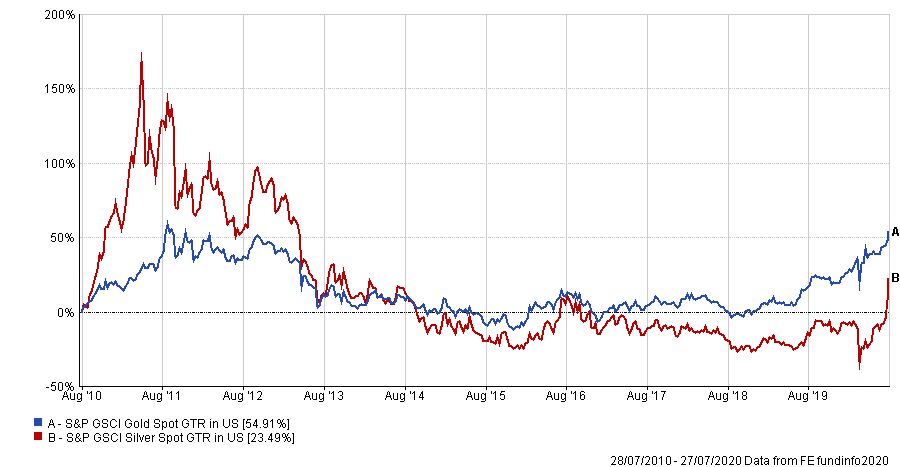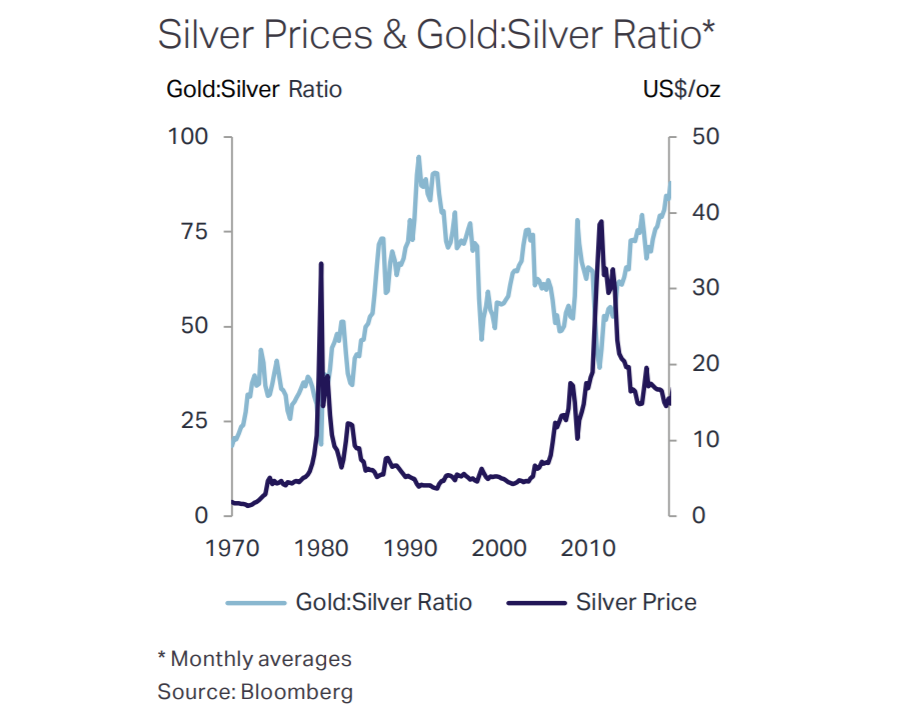As gold makes new highs approaching the $2,000 per ounce mark, many investors have turned their attention to silver which is also breaking new records not seen in years.
Despite a strong rally that has seen the price of silver double from $12 per ounce in March to $24 per ounce today, many managers believe it has much more room to run.
Looking back over the years, silver has reached levels around $50 per ounce twice before, once in the late-1970s and again in 2011.
And according to Ned Naylor-Leyland – precious metals fund manager at Jupiter Asset Management and manager of the $857.6m Merian Gold and Silver fund – the environment of the late-1970s looks quite similar to what we’re going into now: a period of high inflation and relatively low interest rates.
“Not only do I think there’s every chance we’ll reach that level [$50 per ounce] again but we’re probably very likely to go way through it this time,” he argued. “The reason is because once silver starts to go, the only thing that stops it is rising real interest rates.”
Yet, it seems to Ned Naylor-Leyland highly unlikely that central banks would raise rates at any point or that inflation would collapse.
“A collapse in inflation expectations would send silver lower, but we’ve seen when that happens central banks just deliver another entire weapons cache of firepower at the problem,” he explained. “I think this is the time where we go past $50 on a sustained basis.”
The price of gold has breached its 2011 all-time-high, back when there were fears around the Fed’s quantitative easing program, but the price of silver is still less than half of what it was in 2011.
Ned Naylor-Leyland said: “Central bank balance sheets are miles bigger now than they were then, and the promise is that they are going to get miles bigger still, so if that’s the case, silver looks pretty interesting here.”
Performance of gold and silver over 10yrs

Source: FE Analytics
Evy Hambro, co-manager of BlackRock World Mining Investment Trust, said while the gold/silver ratio remains high at 83:1 – the amount of silver in ounces that it takes to purchase one ounce of gold – it has declined from over 120:1 in March.
“Silver typically follows the same trajectory as gold but with a slight lag,” he explained. “Therefore, given our positive view on gold, our outlook for silver is also positive.
“In addition to its ‘safe haven’ benefits, silver is expected to see higher industrial demand via its increasing usage in ‘green’ technologies such as solar panels and electric vehicles.”
Earlier in the year when the price of gold started to pick up, DMS Charteris Gold & Precious Metals manager Ian Williams told Trustnet that he believed silver had more room to run than gold, back when silver was trading at just $13 per ounce.
And even now he argues that silver still has more room to run and silver miners are poised to benefit disproportionately because for the last several years they have been cutting down their costs.
“At current levels some of the higher cost producers all of a sudden are quite profitable companies, and some of the lower cost producers are suddenly on 100 per cent profit margins,” he explained.
“We expect gold to take out $2,000, and silver to go even further. Say silver goes up to $40, some of the shares in our portfolio will potentially go up tenfold.”
Indeed, Williams said the environment for silver today is even more bullish than it was in 2011.
“The trigger point back then was [former Federal Reserve chair] Ben Bernanke starting quantitative easing, and all the investors piled into gold and silver,” he explained.
In 2011, the US Federal Reserve’s balance sheet went from $1trn to $4trn in six and a half years. And Williams contrasted this to today where “it’s gone from $4trn to $7trn in four months”
“And it’s scheduled to do a further $3trn at least by the end of the year, so their balance sheet is going from $4trn to $10trn in nine months,” he continued.
Nitesh Shah, director of research at WisdomTree, said silver will “continue to play catch-up with gold” but getting back to the historic average gold-to-silver ratio of 68:1 “is unlikely”.
“Although silver faces some headwinds from declining industrial demand and potential supply increases, its correlation to gold should act as a strong tailwind,” he added.

Source: The Silver Institute, World Silver Survey 2020
He noted that mined supply of silver has been falling over the years due to declining ore grades at several large primary silver miners, lower silver production at copper mines, and notable disruptions at major silver mines.
He also warned that a Covid-19 disruption in silver mine output – particularly from mines in Mexico, Peru, Bolivia and Quebec – could lead to a rare period of a market supply deficit in silver.
Silver’s industrial uses include electronic components for telecommunications networks and medical applications due to its antibacterial properties.
But Jupiter’s Ned Naylor-Leyland argued that the current economic background is more important to silver than its industrial demand.
“The market for physical silver is dwarfed by its futures market,” he said. “Silver is traded for what it is, a currency.
“Its roots lie in investors finally becoming disenchanted with the flagrant flouting by the world’s central banks and governments of all common sense about sound money.”
“Recent monetary loosening, the swelling of central bank balance sheets, and the spike in government spending in response to the coronavirus may finally have tipped investors over the edge in their distrust of fiat currencies – especially the US dollar,” he finished.





